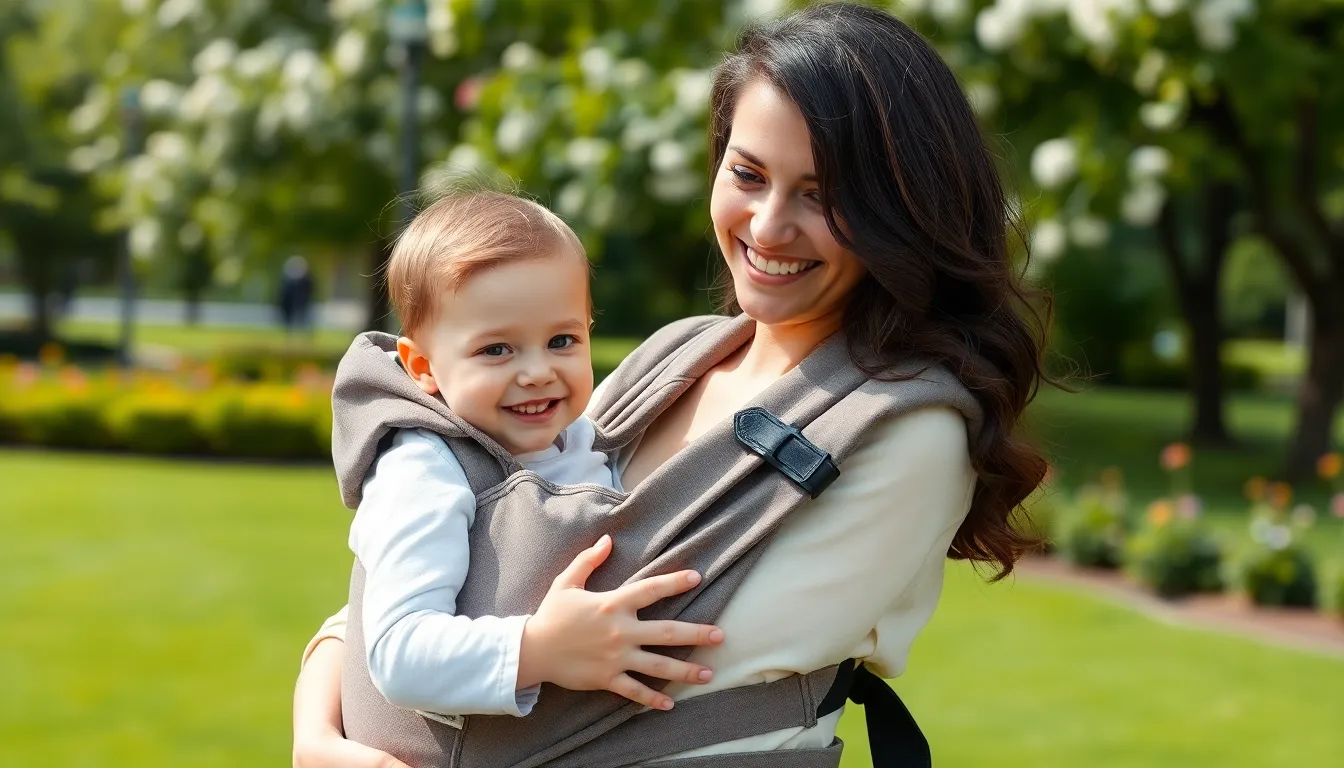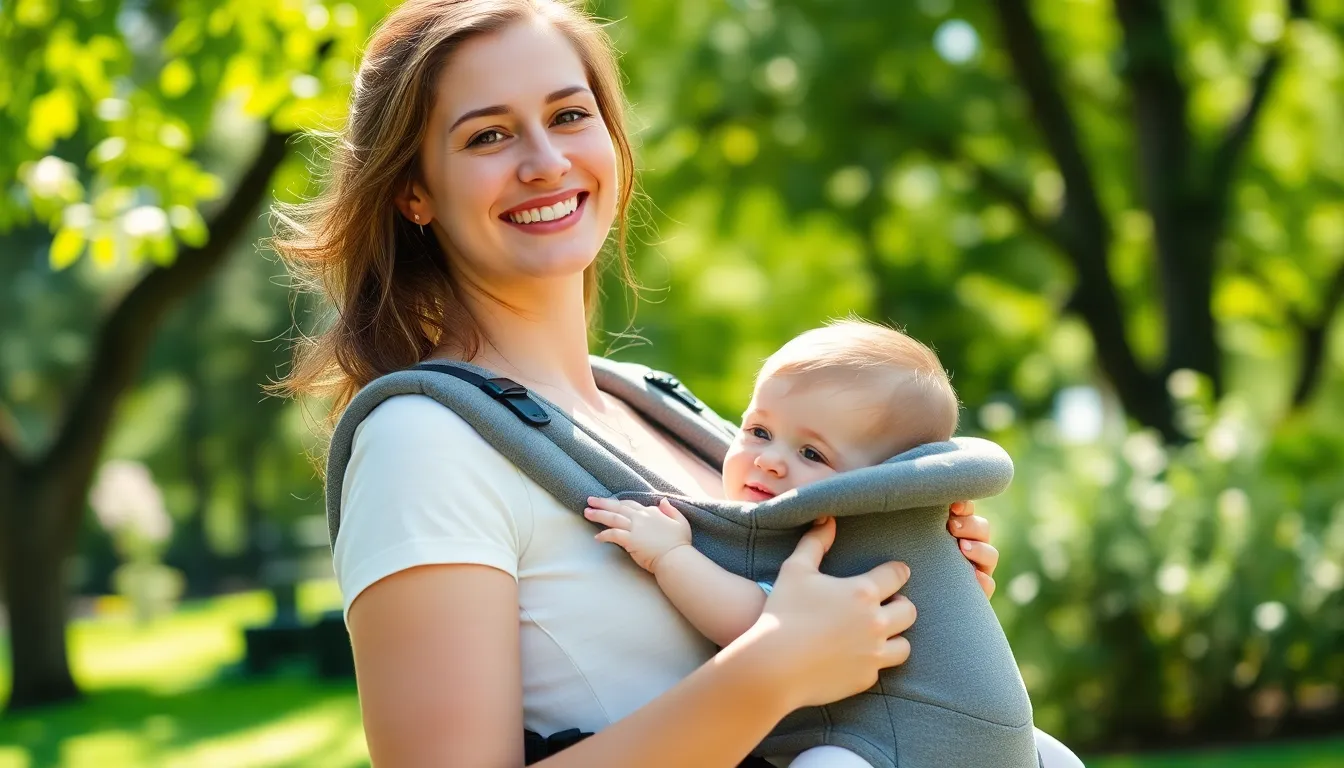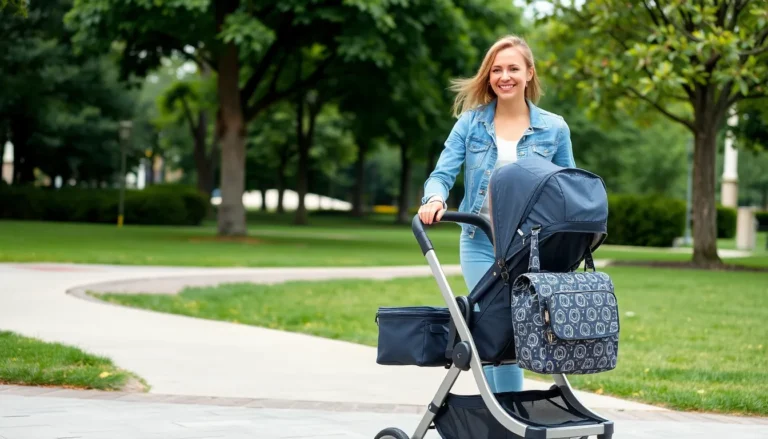Table of Contents
ToggleChoosing the right baby carrier can transform the parenting experience, making it easier to bond with a little one while keeping hands free for daily tasks. With a variety of styles available—from wraps to structured carriers—parents often find themselves overwhelmed by options. Each type offers unique benefits, catering to different lifestyles and preferences.
This guide aims to simplify the selection process by breaking down the most popular baby carriers on the market. By understanding the features and advantages of each type, parents can confidently choose a carrier that best suits their needs and enhances their parenting journey. Whether it’s for a quick trip to the store or a long hike in nature, the right baby carrier can provide comfort and convenience for both parent and child.
Types Of Baby Carriers
Understanding various types of baby carriers helps parents choose the best option for their needs. Each type offers unique benefits and features that cater to different situations.
Wraps
Wraps consist of a long piece of fabric that can be tied in various positions. They provide flexibility and multiple carrying styles, accommodating newborns to toddlers. Wraps evenly distribute weight across the wearer’s body, enhancing comfort during extended use. Parents appreciate wraps for their versatility and adjustability, ensuring a snug fit for the baby.
Slings
Slings are structured fabric loops that offer a simple way to carry a baby. They facilitate quick on-and-off access, making them ideal for busy parents. Slings provide a cozy environment for infants while allowing parents to maintain eye contact. Many slings adjust easily to various body types, making them suitable for both moms and dads.
Structured Carriers
Structured carriers feature a defined frame and padding for support. They often include adjustable straps and buckles, ensuring a secure fit. Structured carriers excel in outdoor settings and longer outings due to their ergonomic designs. They cater to older babies and toddlers, offering various carrying positions to accommodate growth.
Backpack Carriers
Backpack carriers resemble traditional backpacks but with a secure seating area for toddlers. They provide comfort for both the child and the wearer during hikes or outdoor adventures. Backpack carriers typically include additional storage for essentials like snacks and water. Parents value their stability and support, making them ideal for longer journeys.
Benefits Of Using A Baby Carrier

Baby carriers offer multiple advantages, enhancing the parenting experience and promoting a closer connection between parent and child. Below are the key benefits of using a baby carrier.
Bonding With Your Baby
Bonding occurs naturally when parents carry their infants in baby carriers. Proximity promotes emotional security, increasing the feelings of attachment. Skin-to-skin contact during the early months encourages positive interactions between parent and baby, fostering deeper relationships. Regular physical closeness also supports the baby’s emotional and cognitive development.
Hands-Free Convenience
Hands-free convenience allows parents to engage in daily activities while keeping their baby close. Parents can easily complete tasks like shopping or preparing meals without worrying about their baby’s safety. Baby carriers provide the freedom to pursue various activities without the need for bulky strollers. Furthermore, carriers facilitate transitions from home to various environments, ensuring parents maintain mobility.
Health Benefits
Health benefits arise from using baby carriers, both for parent and child. Ergonomic designs support proper posture, reducing physical strain on parents’ backs and shoulders. Carriers also promote healthy hip development in infants by encouraging an legs-in position. Research indicates that carrying infants may reduce the likelihood of colic and promote better sleep patterns. Overall, the use of baby carriers can contribute positively to the well-being of both parties involved.
How To Choose The Right Baby Carrier
Selecting a baby carrier involves considering various factors to ensure comfort and usability for both parent and child. The right choice supports bonding, convenience, and safety during daily activities.
Age And Weight Considerations
When choosing a baby carrier, prioritize the baby’s age and weight. Different carriers accommodate varying weight limits and developmental stages.
- Newborns (0-3 months): Soft wraps or slings provide the necessary support and closeness for young infants.
- Infants (3-12 months): Structured carriers with adjustable features offer versatility while ensuring safety and comfort.
- Toddlers (12 months and up): Backpack carriers excel for older children, providing secure seating and additional storage for outings.
Many carriers specify weight ranges, allowing parents to select options that best fit their child’s growth.
Comfort And Fit
Comfort for both parent and child is essential when selecting a carrier.
- Adjustability: Look for adjustable straps and waistbands to accommodate different body types and preferences.
- Padding: Opt for carriers with ample padding in shoulder straps and back support to reduce strain.
- Breathability: Choose materials that promote airflow, ensuring comfort during extended wear.
Testing the fit before purchasing ensures that it meets individual preferences and provides adequate support.
Ease Of Use
Choosing a carrier that offers simplicity in use enhances the overall experience for parents.
- Quick adjustments: Seek carriers with user-friendly buckles or ties for easy on and off.
- Storage: Some carriers include pockets or storage compartments, adding functionality.
- Portability: Lightweight models can be easily folded and transported, simplifying outings.
Evaluating the ease of use can help prevent frustration during daily activities, making parenting more enjoyable.
Safety Tips For Baby Carrier Usage
Using a baby carrier involves ensuring the safety of the child while maximizing comfort. By following essential safety guidelines, parents can protect their baby and enjoy the experience of carrying them.
Proper Positioning
Proper positioning is crucial for the baby’s safety and comfort. Ensure the baby’s legs are in a natural, spread-squat position, with knees higher than the bottom. Keep the baby’s head close enough to kiss, facilitating breathing and monitoring. Carry infants facing inward to enhance security, while older babies may face outward when developmentally ready. Maintain the baby’s airway clear by checking that the chin is off the chest and the head is not slumped forward.
Choosing Safe Materials
Choosing safe materials is essential for minimizing risks. Select carriers made from non-toxic, breathable fabrics that prevent overheating. Look for certifications, such as OEKO-TEX, indicating that materials are free of harmful substances. Avoid carriers with small parts or embellishments that could pose choking hazards. Ensure the buckles and straps use high-quality materials to provide durability and security during use.
Regular Inspection
Regular inspection of the baby carrier enhances safety. Check the carrier for wear and tear, paying close attention to seams, straps, and buckles. Inspect for loose threads or frayed fabric that could compromise the carrier’s integrity. Test the buckles and adjustments to make sure they function correctly and secure. Cleaning the carrier according to manufacturer instructions can also prevent potential safety issues, such as mold or allergens.
Choosing the right baby carrier can significantly enhance the parenting experience. With various styles and features available parents can find a carrier that suits their lifestyle and meets their child’s needs. The benefits of using a baby carrier go beyond convenience; they foster a deep bond between parent and child while promoting healthy development.
By considering factors like age weight comfort and safety parents can make informed decisions that ensure both comfort and security. Embracing the right baby carrier not only simplifies daily tasks but also enriches the special moments shared with their little ones. With the right choice parents can enjoy hands-free freedom while keeping their baby close.





